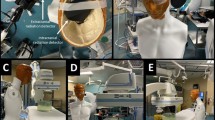Abstract
Background
There has been increasing interest in patient dose reduction in neonatal intensive care units. Removing comfort pads for radiography has been identified as a potential means to decrease patient dose.
Objective
To assess the effect of comfort pads and support trays on detector entrance exposure (DEE) and image quality for neonatal radiography, and its implication for patient dose.
Materials and methods
Comfort pads and support trays from three incubator and warmer systems were examined. The attenuation of the primary beam by these structures was measured using a narrow beam geometry. Their effect on DEE and image quality was then assessed using typical neonatal chest radiography techniques with three configurations: 1) both the comfort pad and support included in the beam, 2) only the support tray included and 3) both the comfort pad and support tray removed.
Results
Comfort pads and support trays were found to attenuate the primary beam by 6–15%. Eliminating these structures from the X-ray beam’s path was found to increase the detector entrance exposure by 28–36% and increase contrast-to-noise ratio by more than 21%, suggesting room for patient dose reduction when the same image quality is maintained.
Conclusion
Comfort pads and tray support devices can have a considerable effect on DEE and image quality, with large variations among different incubator designs. Positioning the image detector directly underneath neonatal patients for radiography is a potential means for patient dose reduction. However, such benefit should be weighed against the risks of moving the patient.







Similar content being viewed by others
References
Goske MJ, Applegate KE, Boylan J et al (2008) The image gently campaign: working together to change practice. AJR Am J Roentgenol 190:273–274
National Research Council (US) Board on Radiation Effects Research (1998) Health risks from exposure to low levels of ionizing radiation: BEIR VII, phase I, letter report. National Academies Press, Washington
Brenner D, Elliston C, Hall E et al (2001) Estimated risks of radiation-induced fatal cancer from pediatric CT. AJR Am J Roentgenol 176:289–296
Smith-Bindman R (2009) Radiation dose associated with common computed tomography examinations and the associated lifetime attributable risk of cancer. Arch Intern Med 169:2078–2086
Walsh L, Shore R, Auvinen A et al (2014) Risks from CT scans--what do recent studies tell us? J Radiol Prot 34:E1–E5
Doss M (2013) Linear no-threshold model vs. radiation hormesis. Dose response 11:480–497
Shepard SJ, Wang J, Flynn M et al (2009) An exposure indicator for digital radiography: AAPM task group 116 (executive summary). Med Phys 36:2898–2914
Rattan AS, Cohen MD (2013) Removal of comfort pads underneath babies: a method of reducing radiation exposure to neonates. Acad Radiol 20:1297–1300
Mutch SJ, Wentworth SD (2007) Imaging the neonate in the incubator: an investigation of the technical, radiological and nursing issues. Br J Radiol 80:902–910
Cohen MD, Markowitz R, Hill J et al (2012) Quality assurance: a comparison study of radiographic exposure for neonatal chest radiographs at 4 academic hospitals. Pediatr Radiol 42:668–673
Figl M, Semturs F, Kaar M et al (2013) Dose sensitivity of three phantoms used for quality assurance in digital mammography. Phys Med Biol 58:N13–N23
Nickoloff EL, Berdon WE, Lu ZF et al (2002) Pediatric high KV/filtered airway radiographs: comparison of CR and film-screen systems. Pediatr Radiol 32:476–484
Speidel BD (1978) Adverse effects of routine procedures on preterm infants. Lancet 311:864–866
Long JG, Philip AG, Lucey JF (1980) Excessive handling as a cause of hypoxemia. Pediatrics 65:203–207
Danford DA, Miske S, Headley J et al (1983) Effects of routine care procedures on transcutaneous oxygen in neonates: a quantitative approach. Arch Dis Child 58:20–23
Slade D, Harrison S, Morris S et al (2005) Neonates do not need to be handled for radiographs. Pediatr Radiol 35:608–611
General Electric Company (2011) Discovery XR656 digital radiographic system operator manual. http://www3.gehealthcare.com/en/Support/Support_Documentation_Library
Conflicts of interest
None
Author information
Authors and Affiliations
Corresponding author
Rights and permissions
About this article
Cite this article
Jiang, X., Baad, M., Reiser, I. et al. Effect of comfort pads and incubator design on neonatal radiography. Pediatr Radiol 46, 112–118 (2016). https://doi.org/10.1007/s00247-015-3450-5
Received:
Revised:
Accepted:
Published:
Issue Date:
DOI: https://doi.org/10.1007/s00247-015-3450-5




